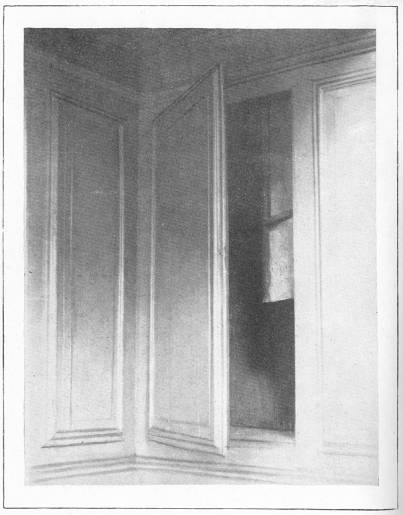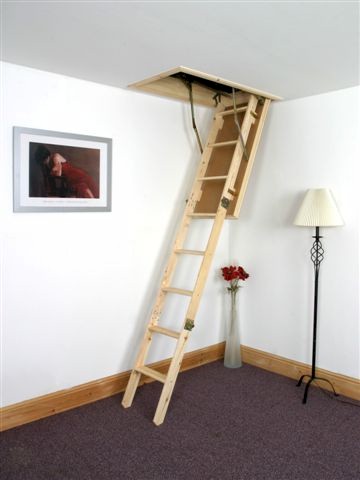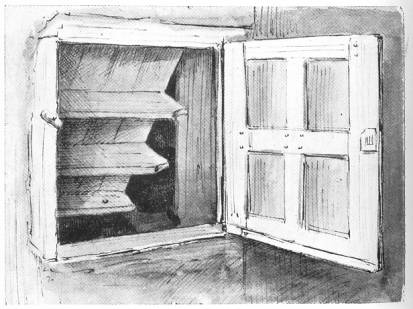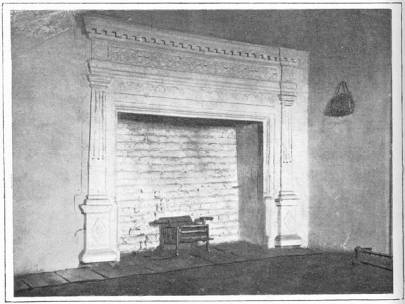For some reason, when our upstairs neighbors came home tonight, their footsteps sounded different – as if someone had come up a staircase I didn’t know about, only to begin speaking inside a room I’d never known was there, located somehow behind the kitchen wall – which got me thinking.
 [Image: From the Secret Chambers and Hiding-Places by Allan Fea].
[Image: From the Secret Chambers and Hiding-Places by Allan Fea].
You’ve been living in an apartment for almost a year, one of three apartments in an otherwise unremarkable building on a street somewhere in the city. You know the building fairly well; you’ve had brief glimpses inside the other apartments; and, with neighboring buildings directly on either side, there should be no major architectural surprises in store.
But one day someone new moves in – and the acoustics of the building begin to change.
You’re suddenly hearing people walk up and down a staircase whose position in the house should be impossible, and you’re picking up conversations that sound as if they’re taking place in rooms that simply cannot be there – voices coming through the walls of the closet, or down through the ceiling of a room that’s supposed to have no rooms above it.
What is going on? Have your neighbors stumbled on some weird system of rooms that no one else ever knew about – and, if so, should they pay more rent?
Or perhaps someone has moved into an apartment in the building next door – only it acoustically overlaps with yours in strange and unpredictable ways.
It’s like something out of Alice In Wonderland, or even Gormenghast. Schrödinger’s Cat as retold by Rem Koolhaas: a potentially unreal maze of interconnected architectural spaces enshrouding you on all sides like a halo. Saint Crawlspace.
 [Image: Via. As if we could travel infinitely upward through architectural space, mapping a labyrinth of trapdoors].
[Image: Via. As if we could travel infinitely upward through architectural space, mapping a labyrinth of trapdoors].
So you begin an investigation. You even record brief snippets of these murmuring conversations to see if the voices match your new neighbors – after all, you’ve spoken to them in the building’s foyer, and you don’t remember them sounding anything like this.
One night a TV seems to be playing – from behind a wall in your bedroom.
It’s too much.
Except then you notice that many walls in the house, particularly down in the entry hall, are actually sealed-over doorframes – and some of the doors in your apartment had once simply been hammered right through the old walls. The interior of the house has been rearranged several times, you see – but of course: how else convert a single-family house into a three-apartment complex?
You even find trace evidence in the back of the kitchen cupboard of a staircase that’s no longer there.
But you’re not hearing ghosts – you don’t believe in ghosts. So is some weird new acoustic effect being demonstrated?
It is the rainy season, your best friend points out; maybe all that moisture in the air has somehow changed the way sound travels through the building… You should talk to an architect, he says, or just dig up old plans of the house. Phone your landlord.
 [Image: From the Secret Chambers and Hiding-Places by Allan Fea].
[Image: From the Secret Chambers and Hiding-Places by Allan Fea].
Instead, you start knocking on walls, tapping around for hollow spots. You tell yourself after work each day that you’ll bob into a hardware store and buy some kind of stud-finder, some technical way to peer through walls, looking for adjacent spaces.
But you never do; you’re too tired – and a stud-finder sounds expensive.
You start daydreaming about radar: you will turn around slowly in the center of your bedroom, holding a machine in both hands, recording the electro-acoustic presence of unknown rooms around you.
It’ll be like that scene in Aliens, you joke to yourself, except you’ll be detecting architectural space.
Perhaps you’ll even find a room that moves, you think. A distant but invisible space, approaching.
Radio astronomy in architectural form.
 [Image: From the Secret Chambers and Hiding-Places by Allan Fea].
[Image: From the Secret Chambers and Hiding-Places by Allan Fea].
But then it stops. The sounds go away. The conversations cease. There is no more radio hum or late-night TV chatter, and when your neighbors come home from work each night it sounds the way it did before. There are no more hidden stairways. No more unexpected rooms.
And so you think it’s all over – till you’re hanging a picture one day. Your hammer goes through the drywall, revealing what looks like a newly furnished room, just hanging out back there in the darkness.
Now, that reminds me of the Navidson house in Danielewski’s “House of Leaves” where a hidden room starts to take on the characteristics of a massive black expanding interior…
This is the post that moved me from RSS reader to commenter, and I was somehow unsurprised to see that reader tautai was already thinking along the same lines.
Your thoughts on ghost spaces within our homes, of course, immediately brought to mind the book House of Leaves, Mark Z. Danielewski’s story of a house that is larger on the inside than it is out on the outside. It is a spiraling encompassing story of a family and an actively growing indoor chasm with staircases and doors sprouting like stalactites.
House of Leaves is extraordinary, and it certainly touches on some of the issues of places as metaphors for the people in them. But the entire thing takes on a new dimension when you hear the album that the Danielewski’s sister, Poe, wrote. Like her brother’s book, this collection of music was a response to the death of their father, but along with all the grief, remembrance and love you’d expect, Poe’s album actually samples her father’s voice. Apparently after his death, she found a collection of cassette tapes of lectures and verbal letters he spoke into a recorder. In one sample, her father says:
“Communication is not just words; communication is… architecture. Because of course it is quite obvious that a house which would be built without the sense… without that desire for communication, would not look the way your house looks today.”
It seemed like something BLDGBLOG might appreciate. 🙂
Wow, I remember that album from way back when. It meant a lot to me at one time.
I had no idea it was linked to a book in that way.
Now I’ll have to read that book!
Or maybe your new neighbours pulled up a carpet and walked around on hard floors in a more reverberant room for a few days before putting a new lining down?
I like your idea better though.
I’m currently reading House of Leaves so, yes, that similarity should be noted.
But it also reminded me of a Jonathan Creek episode; Ghosts Forge, in which one of the main characters disappears in a room with seemingly only one (locked) door.
Yes, this instantly reminded me of House of Leaves as well.
Another sort-of ode to the existential quandry of a house outgrowing its boundaries is the ARG The Dionaea House. The narrative starts here: http://www.dionaea-house.com/
Geoff, I lived in that house. Well, not really, but my second apartment in Boston, when I was a grad student, was a beautiful old Victorian near Coolidge Corner, massive, that the owner had cut into a warren of living spaces. My roommates and I had the second floor–our living room was the old landing off the bedrooms. Behind a sealed door off that landing was what I presume used to be the back stairs, a long, narrow spiral that was the only way to the third floor, where many fraternity members lived.
One night my roommate and I waited until we heard them leave, and then headed down the spiral stairs. Instead of going out, we took a left through what turned out to be a huge basement, now used to store furniture. There was another door, and behind it, a hallway with an exit to the outside world at the other end. The hall, too, was lined with doors. We opened one.
And there were people living inside those rooms, too.
Thanks for these comments – these are great.
AdamR, your story reminds me of a friend-of-a-friend of mine from high school who lived in this wealthy suburb called Chestnut Hill. He was in a band, and so they practiced down in the basement – but in an entire wing of the house that had been sealed off because the house was too big to maintain.
The house was C-shaped, and so we went down – if I even remember this correctly – into one of the branches of the C, walking through one of the largest basements I’d ever seen. You could gradually hear, as you pushed aside curtains and walked further into the dust, the sound of guitars.
I still think about that house, actually, and the fact that anyone, in the 1990s, would actually need to close off parts of their house – and this “wing” of the house was a mansion on its own – because it was too expensive to maintain.
What were those sealed off rooms like?
In fact, I’m reminded of W.G. Sebald, in The Rings of Saturn, an amazing book, where he writes:
“Keeping up the houses even in the most rudimentary way had long been impossible. The paintwork was flaking off the window encasements and the doors; the curtains became threadbare; the wallpaper peeled off the walls; the upholstery was worn out; it was raining in everywhere, and people put out tin tubs, bowls and pots to catch the water. Soon they were obliged to abandon the rooms on the upper storeys, or even whole wings, and retreat to more or less usable quarters on the ground floor. The window panes in the locked-up rooms misted over with cobwebs, dry rot advanced, vermin bore the spores of mould to every nook and cranny, and monstrous brownish-purple and black fungal growths appeared on the walls and ceilings, often the size of an ox-head. The floorboards began to give, the beams of the ceilings sagged, and the panelling and staircases, long since rotten within, crumbled to sulphurous yellow dust, at times overnight. Every so often, usually after a long period of rain or extended droughts or indeed after any change in the weather, a sudden, disastrous collapse would occur in the midst of the encroaching decay that went almost unnoticed, and had assumed the character of normality. Just as people supposed they could hold a particular line, some dramatic and unanticipated deterioration would compel them to evacuate further areas, till they really had no way out and found themselves forced to the last post, prisoners in their own homes.”
In any case, my apartment here in San Francisco is full of sealed-over doors (one right behind our bed), and permanently-closed doors used as walls (two in the kitchen), and bricked up fireplaces and extra rooms turned into walk-in closets. So the new acoustics yesterday seemed oddly fitting to the architecture.
Geoff, have you read Herman Melville’s I and My Chimney? The protagonist owns a house with a monumental chimney around which the house is wrapped. The protagonist’s wife becomes obsessed with the thought that there might be hidden cavities or secret rooms in the chimney, and employs an architect to discover them. Anthony Vidler talks about it in The Architectural Uncanny. You can read the story here, if you haven’t already read it: http://www.gutenberg.org/etext/2694
Carl, I’d never seen that, that’s awesome.
As always, there’s an air of romanticism to the hidden spaces posts on BLDGBLOG, but this also reminded me of the condemned houses close to where I used to live. Originally the houses of Panama’s rich families, they are inhabited today (mostly) by invasors and fire victims who have taken floor size apartments and partitioned into dozens of cuartos, where once inner gardens stood now are flooded with dirt and sewage.
And yet, the other day someone bought one old building -in fact, the whole apple- and found a couple of skeletons from the colonial days. Rather than reporting it to the authorities, removed them and kept the secret in order not to interfere with the remodeling.
So there are spaces unknown where we usually dwell, but some will never be found.
I’d like to refer my fellow readers back to an earlier post about the Undiscovered Bedrooms of Manhattan: one of, if not the very first entries I ever read on BLDGBLOG, and one that got me HOOKED!
Many of the old houses we inhabited during college had dirt floor basements. Some had trees growing in them, some had wells, one supposedly had a grave.
These houses were also split into apartments. So living rooms became bedrooms, doors were sealed of or walled, and all this made for an odd labyrinth effect in some of the larger homes.
Anywhoo, great post!
A friend used to live in a huge old XIX century house like that. Supposedly, that house had once had a basement where the original owner used to torture his servants and family, and that the house was haunted by the daughter of the man, who he’d killed. She was found inside the basement, years after the crime, when then-abandoned house was put back on the market. After that the entrance had supposedly been blocked and hidden by the authorities, the story discredited so as to not hurt the real estate…
We used to do sleepovers there all the time back when we were kids. The grounds were large, and we both enjoyed and feared that there might actually be an entrance to that ancient basement, hidden somewhere in the garden amidst those ancient, crooked trees, maybe near the back porch where the balusters where cracked and moldy and there was an odd placement of the steps, or even concealed underneath the shoddy elevator shaft built in the early 1900s. Of course there were no original plans available and it was all just speculation. Still, at night, the creaking of the walls and floors was enough to keep us awake with terror, and we never walked the house at night, since the old electrical system was completely unreliable…
Now that I think about it, that’s why I’ve always had a weird vibe of familiarity to HP Lovecraft’s work. There is indeed something sinister to the sounds of really old colonial buildings. A sudden shadow, a gust of wind, an incomprehensible whisper… simple things that trigger our fear of hidden agents of unspeakable eldritch terrors lurking somewhere inside our own homes, meeting in dark, dank, impossible spaces made real with unhuman knowledge and unnatural geometries…
Great blog, btw.
Geoff – having lived around Philly for a while, I bet you’re talking about that Chestnut Hill. There are some serious mansions out there that I always fantasized about exploring. I’m glad you did, thanks for the anecdote.
Hey Morgan – I do mean the Chestnut Hill outside Philly. I went to high school around there…
Wow — a house like this is a common theme in my dreams. I actually think I dreamed about the house AdamR mentioned in his comment.
We discovered that the houses on our street all have an extra room behind the laundry room and under the screened porch. The builders just sealed them off instead of expanding the basements into them. Several neighbors have opened them up for extra space.
I love your speculation! This entry reminds me of Michaela Roessner’s Vanishing Point, a complex and fascinating postapocalypic novel set mostly in the Winchester House. Architecture is a large part of the story–I recommend it if you can find a copy.
This is the ultimate foray into auditory apophenia.
My house has a lot of white noise (computer fans, air conditioning, air filters, etc). I’ve never heard voices, but sometimes I hear high pitched ringing in background.
Every once in a while the house creaking/settling sounds will sound like the air conditioner or visa versa. Whenever that happens I get really scared for a second. Your post captured those same feelings for me..